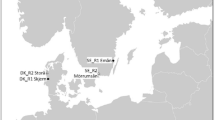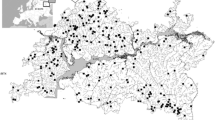Abstract
Habitat structure and physico-chemical variables determine distribution of fish species at local scale. We aimed to determine influences of physico-chemical variables and habitat descriptors on fish assemblage structure in a regulated river in Rio de Janeiro State, Southeastern Brazil. The tested hypotheses are that assemblages are determined by these features at the local scale, and that increased flow during the wet season increases fish abundance and richness because increased habitat availability. Samplings were conducted during the dry and wet seasons in four river reaches (upper, middle-upper, middle-lower and lower), each one covering an extension of c.a. 1,000 m. Fish assemblage differed among the four river reaches because of different habitat structure. Three physico-chemical variables (turbidity, depth and transparency), four habitat descriptors (type of substrate, riparian cover, shelters and type of mesohabitat), erosion and anthropogenic influences were the most significant factors that determined fish assemblage structure. Seasonal changes in assemblage were less conspicuous irrespective of changes in physico-chemical variables. The hypothesis that habitat structure determines local fish assemblage structure was accepted, but only slight increase in fish abundance was found in the wet season. Overall, physico-chemical variables played a lesser role in structuring fish assemblages compared to habitat structure at the local scale.





Similar content being viewed by others
References
Abes SS, Agostinho AA (2001) Spatial patterns in fish distributions and structure of the ichthyocenosis in the Água Nanci stream, upper Paraná River basin, Brazil. Hydrobiologia 445:217–227
Agostinho AA, Gomes JC, Latini JD (2004) Fisheries management in Brazilian reservoirs: lessons from/for South America. Interciencia 29:334–338
Angermeier PL, Karr JR (1983) Fish communities along environmental gradients in a system of tropical streams. Environ Biol Fish 9:117–135
Araújo NB, Tejerina-Garro FL (2009) Influence of environmental variables and anthropogenic pertubations on stream fish assembleges, Upper Paraná River, Central Brasil. Neotrop Ichthyol 7:31–38
Araújo FG, Pinto BCT, Teixeira TP (2009) Longitudinal patterns of fish assemblages in a large tropical river in southeastern Brazil: evaluating environmental influences and some concepts in river ecology. Hydrobiologia 618:89–107
Bain MB, Finn JT, Booke HE (1989) Stream flow regulation and fish community structure. Ecology 69:382–392
Barbiére EB, Kronemberg DMP (1994) Climatologia do litoral sul-sudeste do Estado do Rio de Janeiro. Cad Geociênc Rio de Janeiro 12:57–73
Barthem RB, Ribeiro MCLB, Petrere M Jr (1999) Life strategies of some long-distance migratory catfish in relation to hydroelectric dams in the Amazon basin. Biol Conserv 55:339–345
Casatti L, Castro RMC (2006) Testing the ecomorphological hypothesis in a headwater riffles fish assemblage of the River São Francisco, southeastern Brazil. Neotrop Ichthyol 4:203–214
Crook DA, Robertson AI, Humphries AJKP (2001) The influence of spatial scale and habitat arrangement on diel patterns of habitat use by two lowland river fishes. Oecologia 129:525–533
Dufrêne M, Legendre P (1997) Species assemblages and indicator species: the need for flexible asymmetrical approach. Ecol Monogr 67:345–366
Esteves KE (1996) Feeding ecology of three Astyanax species (Characidae, Tetragonopterinae) from a floodplain lake of Mogi-Guaçú River, Paraná River Basin, Brazil. Environ Biol Fish 46:83–101
Ferreira CP, Casatti L (2006) Influência da estrutura do hábitat sobre a ictiofauna de um riacho em uma micro-bacia de pastagem, São Paulo, Brasil. Rev Bras Zool 23:642–651
Fialho AP, Oliveira LG, Tejerina-Garro FL, Mérona B (2008) Fish-habitat relationship in a tropical river under anthropogenic influences. Hydrobiologia 598:315–324
Flebbe PA, Dolloff CA (1995) Trout use of woody debris and habitat in Appalachian wilderness streams of North Carolina. N Am J Fish Manag 15:579–591
Fukushima M, Kameyama S, Kaneko M, Nakao K, Steel EA (2007) Modelling the effects of dams on freshwater fish distributions in Hokkaido, Japan. Freshw Biol 52:1511–1524
Gehrke PC, Gilligan DM, Barwick M (2002) Changes in fish communities of the Shoal haven River 20 Years after construction of Tallowa Dam, Australia. River Res Appl 18:265–286
Gore JA, Nestler JM, Layzer JB (1989) Instream flow predictions and management options for biota affected by peaking-power hydroelectric operations. Regul River 3:35–48
Gorman OT, Karr JR (1978) Habitat structure and stream fish communities. Ecology 59:507–515
Guenther CB, Spacie A (2006) Changes in fish assemblage structure upstream of impoundments within the Upper Wabash River basin, Indiana. Trans Am Fish Soc 135:570–583
Heino M, Baulier L, Boukal DS, Dunlop ES, Eliassen S, Enberg K, Jorgensen C, Varpe O (2008) Evolution of growth in Gulf of St Lawrence cod? Proc R Soc B Biol Sci B 275:1111–1112
Holmquist JG, Schmidt-Gengenback JM, Yoshioka BB (1998) High dams and marine freshwater linkages: effects on native and introduced fauna in the Caribbean. Conserv Biol 12:621–630
Joy MK, Death RG (2001) Control of freshwater fish and crayfish community structure in Taranaki, New Zealand: dams, diadromy or habitat structure? Freshw Biol 46:417–429
Kramer DL, Rangeley RW, Chapman LJ (1997) Habitat selection: patterns of spatial distribution from behavioural decisions. In: Godin JJ (ed) Behavioural ecology of teleost fishes. Oxford University Press, Oxford, pp 37–80
Leal CG, Junqueira NT, Pompeu PS (2011) Morphology and habitat use by fishes of the Rio das Velhas basin in southeastern Brazil. Environ Biol Fish 90:143–157
Melo TL, Tejerina-Garro FL, Melo CE (2009) Influence of environmental parameters on fish assemblages of a Neotropical river with a flood pulse regime, Central Brazil. Neotrop Ichthyol 7:421–428
Mueller R, Pyron M (2010) Fish assemblages and substrates in the Middle Wabash River, USA. Copeia 1:47–53
Oliveira MP, Tejerina-Garro FG (2010) Distribuição e estrutura das assembleias de peixes em um rio sob influência antropogênica, localizado no alto da bacia do rio Paraná, Brasil Central. Bol Inst Pesca 36:185–195
Park YS, Chang J, Lek S, Cao W, Brosse S (2003) Conservation strategies for endemic fish species threatened by the Three Gorges Dam. Conserv Biol 17:1748–1758
Penczak T, Agostinho AA, Okada EK (1994) Fish diversity and community structure in two tributaries of the Paraná River, Paraná State, Brazil. Hydrobiologia 294:243–251
Pinto BCT, Araújo FG (2007) Assessing of biotic integrity of the fish community in a heavily impacted segment of a tropical river in Brazil. Braz Arch Biol Technol 50:489–502
Poff NL (1997) Landscape filters and species traits: towards mechanistic understanding and prediction in stream ecology. J N Am Benthol Soc 16:391–409
Ribeiro TC, Villalobos GU (2010) Distribution of Agonostomus monticola and Brycon behreae in the Rio Grande de Térraba, Costa Rica and relation with water flow. Neotrop Ichthyol 8:841–849
Schlosser IJ (1987) A conceptual framework for fish communities in small warm water streams. In: Matthews WJ, Heins DC (eds) Community and evolutionary ecology of North American stream fishes. University of Oklahoma Press, Norman, pp 17–24
Smith WS, Petrere M Jr, Barrella W (2009) The fish community of the Sorocaba River Basin in different habitats (State of São Paulo, Brazil). Braz J Biol 69:1015–1025
Stanford JA, Ward JV (2001) Revisiting the serial discontinuity concept. Regul River 17:303–310
Súarez YR, Petrere-Júnior M (2007) Environmental factors predicting fish communities structure of two neotropical rivers in Brazil. Neotrop Ichthyol 5:61–68
Sullivan BE, Rigsby LS, Berndt A, Jones-Wuellner M, Simon TP, Lauer T, Pyron M (2004) Habitat influence on fish community assemblage in an agricultural landscape in four east central Indiana streams. J Freshw Ecol 19:141–148
Talmage PJ, Perry JA, Goldstein RM (2002) Relation of instream habitat and physical conditions to fish communities of agricultural stream in the northern Midwest. North Am J Fish Manag 22:825–833
Taylor CM, Warren ML Jr (2001) Dynamics in species composition of stream fish assemblages: environmental variability and nested subsets. Ecology 82:2320–2330
ter Braak CJF, Smilauer P (2002) CANOCO Reference manual and CanoDraw for Windows user’s guide: Software for Canonical Community Ordination (version 4.5). Microcomputer Power, Ithaca
Valério SB, Súarez YR, Felipe TRA, Tondato KK, Ximenes LQL (2007) Organization patterns of headwater-stream fish communities in the Upper Paraguay-Paraná basins. Hydrobiologia 583:241–250
Acknowledgments
CAPES (Brazilian Agency for Personal Training and Education) provided financial support to the first author and to the many graduate and undergraduate students who helped with fieldwork. CNPq (Brazilian Research Funding Agency) and FAPERJ (Rio de Janeiro State Research Funding Agency) provided partial funding for Araújo. We thank Alex Braz Iacone Santos for final graphic of the study area. This research was conducted under SISBIO Collection of Species Permit number 10707 issued by ICMBio, Brazilian Environmental Agency.
Author information
Authors and Affiliations
Corresponding author
Rights and permissions
About this article
Cite this article
Mattos, T.M., Costa, M.R., Pinto, B.C.T. et al. To what extent are the fish compositions of a regulated river related to physico-chemical variables and habitat structure?. Environ Biol Fish 97, 717–730 (2014). https://doi.org/10.1007/s10641-013-0175-x
Received:
Accepted:
Published:
Issue Date:
DOI: https://doi.org/10.1007/s10641-013-0175-x




